Cihangir
This article includes a list of general references, but it lacks sufficient corresponding inline citations. (December 2017) |
Cihangir | |
|---|---|
Neighborhood | |
 | |
| Coordinates: 41°01′59″N 28°59′07″E / 41.03306°N 28.98528°E | |
| Country | Turkey |
| Region | Istanbul |
| Subregion | Istanbul |
| Province | Istanbul |
| District | Beyoğlu |
| Government | |
| • Headman | Sündüz Ulaman |
| Population (2016) | |
| • Total | 3,549 |
Cihangir is one of the neighborhoods of the Beyoğlu district in Istanbul, Turkey. The neighborhood has many narrow streets, a park, and street cafes. It is located between Taksim Square and Kabataş.
The neighborhood was named after Şehzade Cihangir when his father had Mimar Sinan build a wooden mosque there overlooking the Bosphorus to commemorate his death. The neighborhood's name comes from this mosque.
Etymology
The Istanbul neighborhood of Cihangir was named after Şehzade Cihangir when his father had Mimar Sinan build a wooden mosque there overlooking the Bosphorus to commemorate his death. The neighborhood's name comes from this mosque.The name means "conqueror" in Turkish and, in turn, comes from the Persian compound word jahan + gir (جهانگیر), meaning "conqueror of the world".
Demographics
| Year | Pop. | ±% p.a. |
|---|---|---|
| 2007 | 3,641 | — |
| 2008 | 3,714 | +2.00% |
| 2009 | 3,662 | −1.40% |
| 2010 | 3,722 | +1.64% |
| 2011 | 3,774 | +1.40% |
| 2012 | 3,653 | −3.21% |
| 2013 | 3,761 | +2.96% |
| 2014 | 3,658 | −2.74% |
| 2015 | 3,742 | +2.30% |
| 2016 | 3,549 | −5.16% |
History
During Byzantine times, the area of the present neighborhood was probably not settled, although there were Byzantine buildings near present-day Tophane and Fındıklı along the Bosphorus below Cihangir.
During the reign of Suleiman the Magnificent, the area was a forested hunting ground. It was one of the favorite places of Suleiman's son Cihangir, and after Cihangir's death, Suleiman had Mimar Sinan build a wooden mosque there overlooking the Bosphorus. The neighborhood's name comes from this mosque.
In the last half of the 19th century, the increasing influx of non-Ottoman Europeans into Istanbul drove up real estate prices in the nearby Pera district in Beyoğlu, to which they were officially confined. Some Europeans, however, acquired land in areas outside Pera such as Tophane, Fındıklı, and Cihangir, leading to a great deal of residential development in those neighborhoods.
Starting in the 1930s, non-Muslim residents of Cihangir and the rest of Beyoğlu left or were forced out. They were replaced by Muslims from other Istanbul neighborhoods and by internal migrants from eastern Turkey. As the character of the neighborhood changed, middle-class Muslims also began leaving the neighborhood. By the 1970s, Cihangir was known as a neighborhood where Anatolian migrants lived alongside artists and intellectuals.
References
- ^ Turkish Statistical Institute
- Printed Sources
- Hürel, Haldun (2008). Semtleri, Mahalleri, Caddeleri ve Sokakları A'dan Z'ye İstanbul'un Alfabetik Öyküsü. İkarus. ISBN 978-975-999-290-3.
- İlkuçan, Altan (2004). Gentrification, Community and Consumption: Constructing, Conquering and Contesting "The Republic of Cihangir". Master's thesis, Dept. of Management, Bilkent University, Ankara. http://www.thesis.bilkent.edu.tr/0002485.pdf
- Karpat, Kemal H. (2002). Studies on Ottoman social and political history: Selected articles and essays. Brill. ISBN 9789004121010.
- Kleiss, Wolfram (1965). Topographisch-archäologischer Plan von Istanbul: Verzeichnis der Denkmäler und Fundorte. Verlag Ernst Wasmuth.
External links

